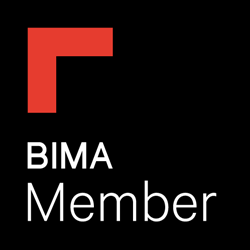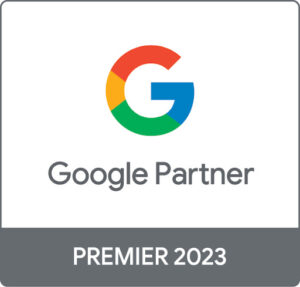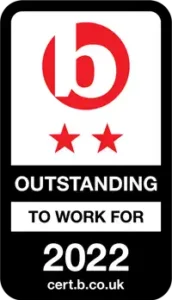Our 2022 PPC Round up
Digital marketing has always been a very fast-paced and forward-thinking industry and 2021 was no exception, in fact, this year it feels like even more has changed than normal!
Anyone who works in this industry must have heard “iOS 14” mentioned at least 100 times in the last 6 months, and that’s just one of the things that have changed in paid search and paid social this year. The industry has had a lot of changes, and most of them have left marketers, feeling like we have less control, or at least this was our first impression.
Being a fan of data, I have always enjoyed having the maximum control over all of my client’s campaigns and being able to segment or report on things at a really granular level. With the introduction of the iOS 14.5 update and Google Ads continued to shift towards automation, it’s proven quite difficult to do that this year, however, these new changes have led to some great results for our clients.
What’s changed?
iOS 14.5
iOS 14.5 was by far the biggest change in paid digital advertising in 2021, none of us knew quite exactly what to expect off the back of this update. At first, it appeared like the impact was very minimal as the initial adoption of this update was fairly slow compared to other iOS releases. However, by the end of June, around 80% of iOS users were running the new OS with its privacy-enhancing / attribution-destroying features.
Facebook Ads was the most majorly impacted advertising platform as a result of Apple’s ATT (App Tracking Transparency) Framework. With a lack of conversions being under-reported, we’ve had to adapt to new methods of improving attribution such as implementing the Conversions API to send event data directly from a website’s servers. This means that we no longer have to only rely on the Facebook Pixel to track events and helps to slightly remedy the big hit that this change had.
Despite being impacted significantly by this change, forecasts still suggest that Facebook Ads spend is going to continue to increase 32.1% in 2021 vs. 2020, as reported in eMarketer. With more brands advertising on Facebook, this leads to continued CPM rises, meaning it is more expensive to get your brand in front of your target audience. However, Facebook ad costs are going to continue to rise, so there’s never been a better time to get started.
TikTok Ads
With TikTok’s rapid growth in 2020 and continued momentum in 2021, it was only a matter of time until the platform launched its own advertising platform. Whilst it’s been around since mid-2020, it has definitely grown in popularity this year with lots of brands deciding to shift some of their Facebook budgets into TikTok due to it being cheaper and having less competition compared to Facebook. This is a paid social channel to watch in 2022 as it is going to continue growing and growing as a new and viable channel for brands to reach their customers.
Smart Shopping
A Google Ads shopping campaign type that was launched in 2018 has become much more popular this year and Google has been pushing this type of campaign more than ever. I was always very sceptical about this campaign type due to not being able to segment/report on key data points like what search terms are our products are appearing for – as this is one of my go-to optimisation points for a poor-performing standard shopping campaign.
It definitely took a lot of trust and getting used to this campaign type but the results speak for themselves (as long as you’re patient!). For most clients where I’ve launched this campaign type, we’ve seen an initial decline in both ad spend and revenue, however, if you give it around 4-6 weeks, Smart Shopping campaigns learn to become very efficient and actually derive more revenue out of less ad spend & clicks. This makes them much more efficient in targeting and thus showing ads for users who are more likely to convert, resulting in less wasted ad spend. I just wish that we were able to see more granular details about this campaign type!
First-Party Data
Similarly to the iOS 14 update, the entire digital marketing industry is leaning towards a more privacy-first approach and this means that this year and in the comings months and years, we’re going to continue to see first-party data taking a more imperative role in digital advertising.
First-party data refers to” information that you collect from your customers, site visitors and app users during their interactions with your products and services.”
With the majority of Google Ads now shifting to more automation and less control for PPC practitioners, it is really important to leverage first-party data to feed machine learning and improve the results you’re able to attain through Smart Bidding.
For example, actions that would usually not get reported into Google Ads like a phone call with one of your sales representatives, this could have massive value to your business and you’d want to strive after more leads like this one, you can make the most of this opportunity by using a tool like GA connector to connect your CRM with Google Analytics. This will allow you to see a range of custom goals in Google Analytics, which can then be imported into Google Ads as conversion actions so that your campaigns are optimising towards these specific actions that are valuable to your business.
Automation
Like most of the changes that I’ve outlined above, automation is one that has been in motion for many years but continued to change the industry in 2021 with Google launching their new campaign type ‘Performance Max’. This a fully-automated campaign type that takes advantage of all of Google’s ad inventory; search, shopping, display, YouTube & maps.
Like all of the aforementioned changes, this one takes control away from the advertiser as right now, you’re currently unable to see how much of the spend/revenue came from each channel e.g. search/shopping. This is a very limiting feature as it is important to understand how each of these channels is performing especially when before each of these channels would have their idea and came back. Despite being unable to see the granular breakdown, initial tests suggest that this campaign type performs really well and being so new… I am sure that this will only improve in years to come.
What do I expect to foresee in 2022?
A Continued Shift Away From Granularity
The majority of the changes in paid digital advertising in 2021 have removed the rains of control from PPC marketers and into the hands of machines.
I imagine that all of the advertising platforms will continue to make this one of their primary focuses in 2022 & beyond, for example, grouping audiences together in one campaign. Using a wider % lookalike etc. will be the way to move forward. This is something that we’ve seen great results from this year and I’m sure this will continue into 2022.
More Privacy Based Features
Users are becoming more concerned about their privacy online. With Apple’s iOS 14.5 update and then iOS 15 updates which had a similar effect for email marketing, it is likely that a lot of other big tech companies will follow suit with their own privacy solutions. Google is currently in the process of launching Consent Mode which “allows you to adjust hoe your Google tags behave based on the consent status of your users.” This helps businesses to remain GDPR compliant whilst continuing to track the activity of users who consent to it.
More Strong Results
Despite all of the changes being mainly doom and gloom and taking control away from marketers, the results that we’ve seen in 2021 have continued to be strong. The majority of results we’ve seen from these changes or from experimenting with new campaign types have been very positive. I’m sure as machine learning continues to develop, these results will improve even more throughout 2022.








